Innerlandia -- The Unexplored Continent Within Your Body
David Noel
<davidn@aoi.com.au>
Ben Franklin Centre for Theoretical Research
PO Box 27, Subiaco, WA 6008, Australia.
"The past is a foreign country, they do things differently there."
-- LP Hartley, "The Go-Between"
The Past is A Foreign Country
It's a truism that the pace of change and development these days is uncomfortably fast. Uncomfortable, because it's hard for an older person to just junk much of their experience, knowledge, and habits to meet an ever-changing world.
Undoubtedly many of the changes have been very beneficial for the human race. Modern advances have brought us better medicine, far improved technology, and a generally improved standard of living.
And yet, not everything in the garden is rosy. Advancing almost in step with the general improvement, there have been some disquieting and puzzling backward movements, many of which concern health of the populace. A huge rise in allergies and other auto-immune disorders, the emergence of food intolerances, the appearance of early-onset dementia, and declines in general fertility are just a few of these.
In this article, we'll look rather more closely than usual at some of the changes which have taken place, and try and extract possible reasons for the downsides which are sapping some of the benefits of the upsides.
BC and AD
I was born in 1935, a few years before the Second World War. As the quotation at the head of this article says, this period is effectively another world altogether, they do things quite differently there.
It's easy to lose sight of how much things have changed. Older people today may have trouble keeping up with all the changes. On the other hand, today's younger generation would be quite baffled and confused if they were thrust back into these 'Dark Ages', and had to cope with life as it was then.
For convenience, in this article we'll refer to the earlier period, the latter half of the 1930s, as BC (Before Computers). The modern period, in which we sit, we'll called AD (After DVDs).
There is a nice parody on YouTube, called "Capstick Comes Home" [4], of how people hark back to the 'Good Old Days'. Humour aside, general living conditions, even for those in developed countries such as Britain, have improved out of sight.
Back in BC, I lived in a number of houses at different times. Some had no electricity, others no flush toilet (just an earth closet), others no mains water supply. None had showers. In one, to have a bath, you dragged out the tin tub and filled it with hot water from jugs on the stove.
In one English village (Rickling in Hertfordshire), over half the villagers drew their water from a hand-powered iron pump on the village green -- like that in Fig. ILF1 (a modern reproduction), but rather plainer and more rusty. These pumps were connected to a metal pipe which went down into, and drew water from, the water table.

Figure ILF1. A cast-iron manual water pump. From [5].
And yet there were other technologies much more obvious than in AD. The Rickling Village house, which had no mains electricity, did have piped gas (and gas lights for illumination). Gas in BC was Town Gas, made from coal. It was stored in huge containers called gasometers, like that in Fig. ILF2 -- these had huge floating inverted metal cups, which rose and fell as gas was pumped in or out. The picture is of the gasometer at one end of the Oval cricket ground in London, still called the 'Gasometer End'.

Figure ILF2. Gasometer outside the Oval cricket ground in London. From [6].
Many of the street lights in London and its suburbs were still powered by town gas until well into the 1950s. And yes, they still needed a 'lamplighter', a man who had a long pole to turn on each light individually at dusk.
On the other hand, back in BC there was no bottled gas, like that now used in gas barbecues or country kitchens. At one house, my mother cooked on a small kerosene stove.

Figure ILF3. A 'Beatrice' kerosene stove. From [11].
The Rise of Electronics
Back in BC, computers had yet to be invented. Radio broadcasts were normal, but the big receiving sets ran on large 'valves' or 'tubes' like light bulbs, the early equivalent of transistors. Printed circuits were far in the future. Public television was only in its experimental stages.
Telephones were all connected by wires to the local (often manually operated) telephone exchange. Sometimes one wire was shared between several subscribers (a 'party line'). Making an overseas phone call was very expensive and complicated, needing a booking several days ahead.
Now, in AD, we are used to instant access anywhere in the world, using ever more versatile mobile phones which incorporate powerful computers and can transmit pictures and videos. Some countries, such as Vietnam, have mostly leap-frogged the landline connection stage and now run on mobile phone signals.
Back in BC, small portable radios were just a science-fiction idea -- the comic-strip detective Dick Tracy was notable for his amazing 'wrist radio'. But this was not until 1946! [7].

Deep-Rooted Social Changes
In step with the constant improvement in computers, communication facilities, and manufactured devices available, there have been sea-changes in public attitudes and behaviour concerning how our lives are led. Of course, these changes have been very dependent on where you are on the planet, some populations have strongly resisted change, others have been mostly swept up in the tsunami of 'progress'.
It is important, in what follows, to temper what is said by always bearing in mind which population is being examined, and the period at which it is being examined, in the theme being looked at. I'll be mostly concerned with 'modern', 'western' countries, with particular reference to England (BC) and Australia (AD).
There has surely been a marked increase in the 'gap' between a 'backward' and a 'modern' country when you compare the gap back in BC, and the corresponding 'gap' now in AD. Some indication of the quantitative value of the gaps, and of the bases from which they are measured, can be gained from their 'infocap' levels [8], which are crudely reflected in their per-capita Gross National Product values.
Younger people living now in AD might well be astonished to find out that so many of the social conventions and habits they are used to, did not exist back in BC. Back then, attitudes (and laws) relating to sexual matters were totally different. Children not generated within an official and legal marriage were greatly disadvantaged. Such 'bastards' (many today may not even know the origin of the word) were often the objects of shame and abuse, or were 'put out for adoption'.
Our AD attitudes towards such things as the environment, supermarkets, junk food, in-vitro fertilization, global warming, whales, sustainability, organic foods, multinational companies, development aid, deforestation, and space travel, are not just different from those prevailing in BC. In BC there were no such attitudes. BC is a foreign country, they do things differently there.
Health, Medicine, and Life Expectancies
Over the years since BC, there have been vast improvements in medicine, affecting both individual and public health. Antibiotics have led to new success in dealing with diseases of many kinds. Organ transplants have given new leases of life to many. Effective birth control measures have changed everyday life for much of the population. The discovery of DNA and analysis of genomes has been hugely important.
Changes in public health attitudes have also altered life. In BC, government campaigns were directed against spitting in the streets, urging us to "trap the germs in your handkerchief". In AD, cigarettes, once routinely issued free to those in the armed services, are actively discouraged.
Public hygiene now has wide attention, with tongs being used to handle cakes, wash-basins provided at all public toilets (yes, this wasn't always so), and most food products sold in sealed wrapping. 'Use-by' or 'Best before' dates for edibles are usually mandatory in AD.
Between BC and AD, life expectancies have greatly increased in many countries, sometimes doubled. Whole branches of medicine have grown up to handle problems of the aged, such as artificial joint replacements, and deteriorating physiological processes in the brain, in glands such as the prostate, in the circulatory system, and in the lungs.
Problems of Aging and Society
No doubt with increased life expectancies, increases in problems associated with aging are only to be expected. But, as well as these problems, there has occurred a puzzling rise in problems which once hardly existed.
Allergies are a notable example. In AD, peanut allergies can be a great concern, with foods labelled "manufactured on machinery also used to handle peanuts" to identify possible tiny traces. In previous times I was involved with the nut trade, and read a great deal on the topic, but I never even heard of such allergies until they emerged suddenly in the 1970s.
A daunting modern problem, hardly existing in BC, is early-onset dementia. Some loss of mental facilities is to be expected with increasing age, but the early-onset phenomenon is relatively new.
Another problem, looming larger and larger in today's world, is that of diabetes. Diabetes incidences have risen sharply since BC, and especially so as countries have modernized. Disturbingly, early-onset diabetes is now detected in quite young children.
Food intolerances, and other digestive problems, seem to figure much more largely in AD than they ever did in BC. Yet attention to food quality and safety has never been higher than it is today.
About Diabetes
Let's look more closely at one such 'modern' ailment, diabetes. Diabetes is a name for a flaw which can arise in human (and other) physiologies when blood-sugar levels get out of kilter. This happens because not enough insulin is produced naturally in the body -- the blood ecosystem gets out of balance. The insulin regulates blood glucose, and is produced in the pancreas. Back in BC, the only effective treatment for diabetes was to eat raw liver each day. In AD, diabetes is controlled by insulin injections, but these only alleviate the problem, diabetics still face a host of ongoing medical problems.
Tables are available for diabetes incidence in many of the world's countries [24], with recorded figures for 1995 and 2000, plus projections for 2030. There have undoubtedly been big increases in diabetes over recent decades, especially in 'western' or developed countries. So far, no plausible reason for this rather devastating occurrence has found the light of day.
One obvious possible culprit is the increasing consumption of sugar in the west, especially of corn syrup sugars. To check a possible correlation between sugar consumption and diabetes incidence, Ann Nolan has analysed the figures for 2000 and 2011 [21], and plotted graphs, two of which are shown below.
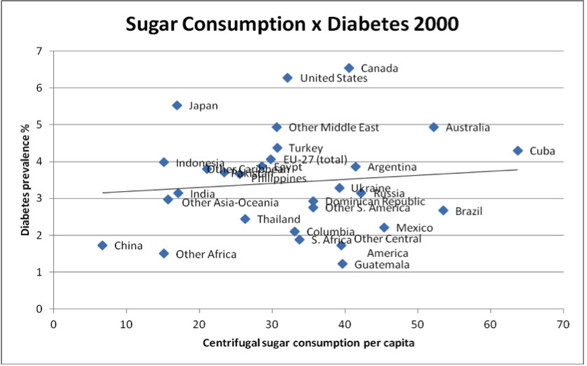
Figure ILF5. Sugar vs Diabetes, 2000. From [21].
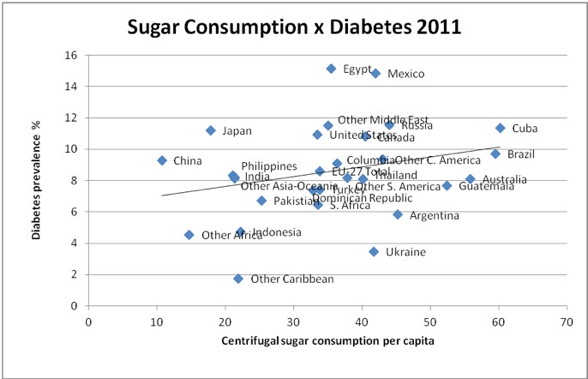
Figure ILF6. Sugar vs Diabetes, 2011. From [21].
Looking at the plots, it is obvious that they do not show any significant correlation between sugar consumption and diabetes incidence. But they do reveal a frightening increase in diabetes over only 11 years. In 2000, Canada and the US, typifying developed countries, had between 6% and 7% diabetics, and were then at the top of the incidence scales. By 2011, diabetes in these two countries had increased to around 11%.
Looking then at some of the 'developing' countries, racing to catch up with the West, their placings in the Diabetes Stakes have put them up and beyond the old leaders. Egypt and Mexico, formerly between 2 and 4%, are now the leaders, each at around 15%. China, a star in the development contest, has raced from under 2% to around 9%.
The bottom line is, most countries of the world are facing a truly enormous problem in increasing diabetes, one almost certainly tied up with changes to everyday behaviour over the years. And this problem is completely stumping conventional medicine and the established authorities.
Is There an Explanation for some Modern Ills?
Let's look at some of the aspects of how human bodies function, and see if we can extract some often-neglected, or even unrecognized, factors. We'll concentrate in particular on the digestive system.
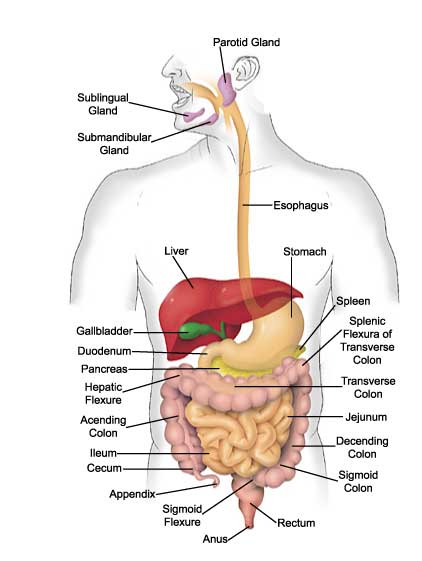
Figure ILF7. The human digestive system. From [9].
As can be seen from Fig. ILF7, the digestive system has a lot of parts to it. The basic picture is that food comes in at the mouth and makes its way down to the stomach. At various points, enzymes and chemicals are added, in particular a lot of hydrochloric acid in the stomach.
After the stomach, the processed mass passes through quite a long section (over 8 metres) of intestines, on its way to the anus. Again various substances are added, and in addition, nutrients generated in the complex processes may be extracted, particularly in the intermediate section of the small intestine, the jejunum, which is about two and a half metres long.
It is in the jejunum where nutrients resulting from the digestive process are mostly exported from the digestive system and into the bloodstream, for use elsewhere in the body. The inside of the jejunum has huge numbers of projecting fingers, called villi, where the transfer takes place.
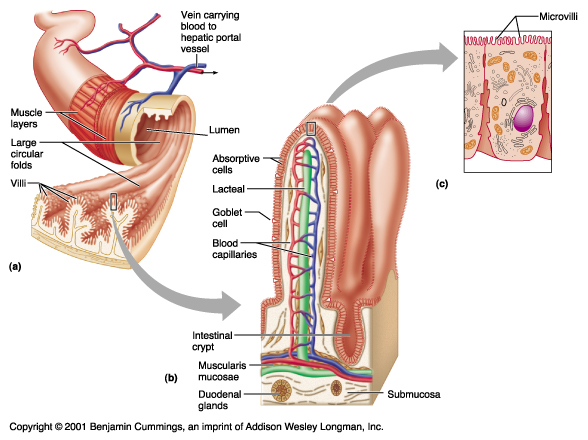
Figure ILF8. Inside the small intestine. From [10].
The villi are covered with even smaller villi, called microvilli. The set-up provides a huge area of transfer surface where substances from the digestive system can pass through selective 'filter membranes' to enter the blood.
You might think from this, that the digestive system is like a product line in a chemical factory, with raw materials going in at one end, and useful product and waste coming out at the other. In fact, it is far more complex and subtle than that. This is because the digestive system is actually a whole ecosystem, quite separate from the rest of the body, and with quite different inhabitants working together to make effective ecosystem operation.
The Continents of Planet Corpus
We can draw an analogy with the function systems of the human body, by representing each system as a continent.
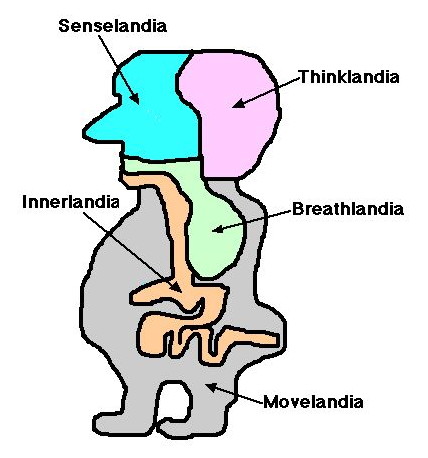
Figure ILF9. Continents of Planet Corpus.
In Figure ILF9, the human body is shown divided up into five ecosystems or 'continents' (obviously this is very simplified). The digestive system is called 'Innerlandia'. It is quite different to the other four, these are intricately interconnected, with networks of nerves, blood vessels, lymphatic systems, and bones (with continents, these might be railways, roads, telephone lines, canals, and so on).
Innerlandia lacks all such interconnections. Its boundaries, such as the microvilli in the jejunum (Fig. ILF8), are like an all-enclosing wire frontier fence -- within Innerlandia there are none of the networks interlinking the other four ecosystems.
In a way, Innerlandia is like Antarctica is on Planet Earth. Antarctica lacks all the railways, roads, telephone cables, and canals which can be found threading through and interlinking the inhabited continents.
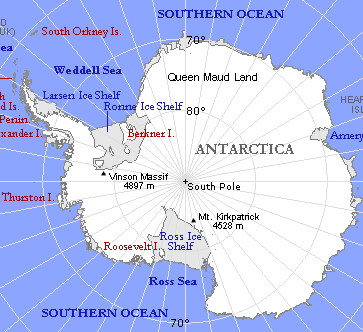
Figure ILF10. Antarctica. From [12].
Antarctica also resembles Innerlandia in that it is still largely unknown in any detail. Conventional history has it that it was first known to civilization in 1772, when the explorer James Cook circled it, without sighting the land, but inferred its presence from icebergs floating in the region. The Antarctic mainland is recorded as being first sighted by Russian expeditions around 1820 [14].
In a fascinating aside, this modern picture is turned on its head by the depiction of the Antarctic continent, with quite good accuracy, in a map of the world made by Oronce Fine in 1532!
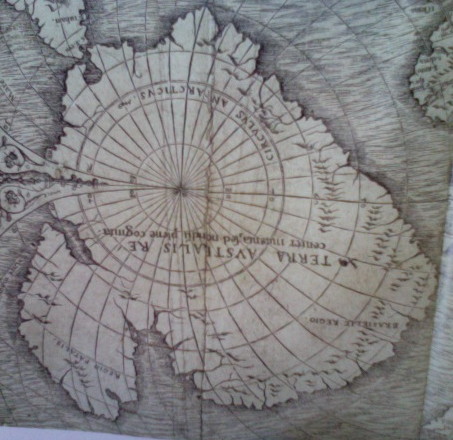
Figure ILF11. Antarctica as depicted on Oronce Fine's 1532 Map Of The World. From [13].
An even more fascinating detail is that Fine's map shows Antarctica without the prominent Ross and Ronne Ice Shelves seen today, and without the offshore island chain which would be seen linking Antarctica to South America if their ice cover was removed. There is an explanation for this apparent anachronism, but it won't be gone into here.
Another parallel between Antarctica and Innerlandia is that both hold no human inhabitants (OK, there are research teams in Antarctica in recent years, but these are not inhabitants in the sense of families living normal lives). For Innerlandia, this may be a surprising thought, but it is nonetheless true.
As well as being intricately connected, the other four ecosystems of Planet Corpus principally consist of human cells working in close cooperation, generally inter-compatible. For example, if someone's earlobe needs to be maintained while part of their skull is being rebuilt over a period of weeks, the ear can be 'parked' on their arm, say, while the skull heals, and rejoined later.
There would normally be no problem on their own arm, but grafted onto another person's arm, the earlobe would be rejected -- the individual's cells recognize and accept their own cells, but fight off cells with different DNA.
Interlandia is a very alien body system, one not accepting self-human cells. If you cut off one of your toes and swallowed it, your digestive system would treat it like any other piece of meat -- and turn it into nutrients and waste.
Make-up of the human body
Examination of the DNA of cells contained within the human body reveals an astonishing thing. Under the title Humans Carry More Bacterial Cells than Human Ones [17], a Melinda Wenner article shows that more than 90% of the cells in our bodies are not human. Most of these are bacteria, and the big majority of these non-human cells live in our digestive system.
Here is more from [17]: All the bacteria living inside you would fill a [two-litre] jug; there are 10 times more bacterial cells in your body than human cells, according to Carolyn Bohach, a microbiologist at the University of Idaho. Despite their vast numbers, bacteria don't take up that much space because bacteria are far smaller than human cells. Infestation begins at birth: babies ingest mouthfuls of bacteria during birthing and pick up plenty more from their mother's skin and milk -- during breast-feeding, the mammary glands become colonized with bacteria. "Our interaction with our mother is the biggest burst of microbes that we get," says Gary Huffnagle, a microbiologist and internist at the University of Michigan at Ann Arbor. And that's just for starters: throughout our lives, we consume bacteria in our food and water.
Starting in the mouth, nose or other orifices, these microbes travel through the esophagus, stomach and / or intestines -- locations where most of them set up camp. There are estimated to be more than 500 species living at any one time in an adult intestine. For a long time, scientists assumed that these bacteria, despite their numbers, neither did us much harm nor much good. But in the past decade or so, researchers have changed their tune.
For one thing, bacteria produce chemicals that help us harness energy and nutrients from our food, Huffnagle explains. Germ-free rodents have to consume nearly a third more calories than normal rodents to maintain their body weight, and when the same animals were later given a dose of bacteria, their body fat levels spiked, even if they didn't eat any more than they had before. Intestinal bacteria also appear to keep our immune systems healthy. Several studies suggest that microbes regulate the population and density of intestinal immune cells by aiding in the development of gut-associated lymphoid tissues that mediate a variety of immune functions.
The bacteria also appear to influence the function of immune cells like dendritic cells, T cells and B cells, although scientists don't know the precise mechanisms yet. And one chemical released by the bacterium Bacteroides fragilis is capable of directing how the developing immune system matures. Further, probiotics -- dietary supplements containing potentially beneficial microbes -- have been shown to boost immunity. Not only do gut bacteria "help protect against other disease-causing bacteria that might come from your food and water," Huffnagle says, "they truly represent another arm of the immune system."
Of course, they can't protect against every onslaught, which is why we still have to depend on antibiotics to rid us of some disease-causing infections. But antibiotics don't just kill off the "bad" microbes, they wipe out the "good" ones, too. That's why antibiotic use can cause diarrhea and upset stomach -- the drugs interfere with the balance of our bacterial flora, making us sick, Huffnagle explains.
One thing is for sure: our lives and even our identities are more closely linked to the microbial world than we may think. Bacteria do a lot to keep us healthy, and scientists are just beginning to uncover their valuable secrets. As UI's Bohach says: "We do not completely understand the full impact of our bacterial flora on our health and physiology. We compulsively wash our hands, spray our countertops and grimace when someone sneezes near us -- in fact, we do everything we can to avoid unnecessary encounters with the germ world. But the truth is, we are practically walking petri dishes, rife with bacterial colonies from our skin to the deepest recesses of our guts."
Innerlandia ecology
It's clear from what has just been said that our digestive systems are far, far more than a simple chemical process stream. In fact, Innerlandia contains a very extensive and varied ecology. This ecology is made up of interacting creatures and processes quite different to those elsewhere in Planet Corpus. It contains no humans. And it is very varied. An explorer moving along the digestive tract zones would continually come up against another new set of inhabitants with their own distinctive ecology. But all the ecologies cooperate and interact.
Conditions in the different zones of Innerlandia are definitely not suitable for humans. Everything in your stomach is bathed in quite strong hydrochloric acid, bringing the pH down to 1.5 - 3.0. After the stomach, the pH rises to pH 4.6-8.0 (pH 7 is neutral).
Humans would also find the atmosphere in Innerlandia rather unsuitable. According to [35], the composition of farts is as follows. Nitrogen: 20–90%; Hydrogen: 0–50%; Carbon dioxide: 10–30%; Oxygen: 0–10%; and Methane: 0–10%. The creatures of Innerlandia live in an atmosphere which may have no oxygen, and is definitely inflammable.
We know from DNA studies on humans that every single person (other than same-egg twins etc) has their own distinctive DNA. When it comes to a person's Innerlandia DNA, which is a complex mix from thousands of different species, that will be varied to an even higher degree. There may be a forensic tool here.
Levels Of Logic -- Why Ecosystems Need different Logic
Everything we are involved with has to embrace decisions. Decisions involve logic. It's very important that the type of logic needed to make a decision is matched with, and suited to, the level of the entity involved.
So we need to diverge a bit here to look at different levels of logic. The simplest logic, what we might call 'Base Logic', is the one we use most in everyday life. There's usually a simple one-way path, where a need arises, and the need is satisfied by an action. We need potatoes, say, so we go to the supermarket and buy some.
Another type of logic, rather more complex, we could call 'Wide Logic'. With this, the logic needs to apply to a situation or standpoint, which is affected by a number of factors, some of which may be in conflict, some of which may be imperfectly known. In this case, we usually seek to attain an optimal position, one which best balances the upsides and the downsides of the active factors.
Say we are intending to visit a foreign country, one where a particular disease is prevalent, a disease which we do not wish to catch. At one extreme, we could avoid the disease by cancelling the trip, and avoiding exposure. At the other end, we could take the trip but insist on screening out all possible contacts and places overseas where the disease might exist. Perhaps the optimal position might be to have inoculations against the disease, to reduce its bad effects if encountered.
A third level of logic we might call 'Matrix Logic'. Matrix Logic applies in situations involving ecosystems, where the number of variables is so high that Base Logic has no hope of success -- it's impossible to guess, with any hope of success, what set of results (if any) will stem from a single action.
Those interested in the background to Matrix Logic might like to look at my book Matrix Thinking [23, 25]. There, the types of self-sustaining, self-organizing ecosystems, of which Innerlandia is one, are generalized into what is called a 'syston', which could be anything from a national government to an ant colony.
The important thing is that simple Base Logic is of no use to us in deciding matters concerning ecosystems. It's similar to Chaos Theory, where the number of variables is also so great that standard logic cannot apply. Instead, at present we have only a few Rules Of Thumb as a guide to what to do. Here are some of them.
Rule 1. Ecosystems are the more stable and the more resistant to outside influences, the more complex they are and the higher their infocap [8] content. ("Stability through diversity").
Rule 2. Ecosystems will best resist a possibly harmful action from outside if they are introduced to it gradually, step and retreat, and have time to adapt to it.
Rule 3. Ecosystems are massively interlinked and complex organisms, and typically require to be grown, matured, and nurtured over extensive periods. One-shot treatments may either take time to show effects, or if sufficiently potent, may disrupt or destroy the ecosystem.
Rule 4. Ecosystems may interact favourably or unfavourably with another similarly organized ecosystem, over time [it's called love].
Rule 5. Introduction of outside influences to an ecosystem may have positive effects, but the improvement may be slow and will likely involve partial suppression or loss of some of its existing elements.
As a practical illustration of this, suppose you had been brought up in northern Europe and never been outside of it, but now needed to take up a job in a backward, tropical country. You would cope with the change better, if it was possible for you to fly to the country for a few days only, return home for a month, then visit for 2 weeks and so on. Your immune systems would cope better.
Human immune systems almost certainly carry far, far more disease antibodies in their bloodstreams than any other species. This is especially true in AD, when such a high proportion of the world's population has either visited several foreign countries, or been exposed to visitors from foreign countries.
This is not just a matter of being careful about catching diseases. In earlier years, whole populations have been decimated, even driven to extinction, by their first contacts with outsiders from more cosmopolitan societies (read: having more disease antibodies). Here is some history [31] concerning the people of the Andaman Islands, an archipelago in the Indian Ocean, between peninsular India and Burma.
"Decline of the populations. The Andamanese's protective isolation changed with the first British colonial presence (in 1789) and subsequent settlements, which proved disastrous for them. Lacking immunity against common diseases of the Eurasian mainland, the large Jarawa habitats on the southeastern regions of South Andaman Island were likely depopulated by disease within four years of the initial British colonial settlement in 1789. Epidemics of pneumonia, measles and influenza spread rapidly and exacted heavy tolls, as did alcoholism. By 1875, the Andamanese were already "perilously close to extinction."
"At the time of first contact with the British there were an estimated 5,000 Great Andamanese. By 1901, 600 were left. By 1927 only 100 survivors remained. Around independence, the number had shrunk to 25. Fourteen years after independence, in 1961, only 19 remained. The numbers have rebounded somewhat and today about 50 remain, which is still far too small for a self-sustaining society. The Aka-Kol of Middle Andaman were extinct by 1921. The last Jangil (also known as the Rutland Jarawa) were sighted in 1907, and were assumed extinct by 1931, as were the Oko-Juwoi. Today only the Sentinelese (who live exclusively on North Sentinel Island) have been able to completely maintain their status as an independent, self-sufficient population, resisting attempts to contact them."

Figure ILF12. Two Great Andamanese men, in an 1875 photograph. From [31].
The destruction and loss of so many of the Andamanese people is an especially bad case. But milder cases are common whenever one population, one ecosystem, has come into contact with another. Taken slowly and in small steps, both ecosystems can survive, and even mutually benefit by taking in useful elements of the other.
Mis-Applying Base Logic
Unfortunately, mis-application of simple Base Logic to a complex ecosystem is a common occurrence. Australia generally has a high incidence of sunlight. Excess sunlight can cause skin cancers. Both these factors are not disputed.
Australia is one of the most regulated societies in the world, some of its critics decry it as a 'Nanny State'. It's illegal to wire up your own electric plug without a licence, cyclists must wear crash helmets, all milk sold for consumption (even by pets) must be pasteurized, and so on.
When it comes to exposure to sunlight, authorities are very careful about children getting bad effects from it. Most primary schools now require children under their care to wear large floppy hats outside, even if the sun is not out. "No hat, no play" is the rule.

Figure ILF13. A typical Australian primary school hat. "Blue school hat with wide brim. Children are expected to wear their school hat in order to play in the playground as part of our SUN SAFE POLICY." From [30].
It makes sense to wear a hat if you are going to be out in the sun for a long time or in the middle of a hot day, but the primary school concerned is using very basic logic, a black-and-white view. This is misguided for two reasons.
The first reason is that human beings depend on skin exposure to sunlight to generate much of their required Vitamin D. Insufficient Vitamin D in the system can lead to a host of medical problems, such as osteoporosis, rickets, and impaired cellular functions such as cell differentiation [32]. So some sun exposure is necessary for health. This can be a problem in very high latitude countries, but should not matter under normal circumstances in Australia. However, Muslim women who customarily wear burkhas or other full dress covering their faces, as well as other skin parts, are liable to Vitamin D deficiency problems [33].
The second, and perhaps more important, reason is that some exposure to sunlight 'conditions' the body to accept a later exposure without the same liability to sunburn. By cutting off most sun exposure in these children, they may become more sensitive to the sun later on.
This 'conditioning' phenomenon has the same implications as those mentioned above, that ecosystems will be more tolerant of intrusions which might involve immune reactions if they have small regular exposures first. The principle is surprisingly widely applicable -- the body can develop tolerance to cyanide poisoning, even to radioactive exposure, with preliminary small doses.
About Milk
Milk is, of course, the defining feature of the class of higher organisms called mammals. Milk is produced in the breasts (udders, tits) of females and is usually the main food source for the developing young after their birth.
Arguments over whether breast-feeding is good, or necessary, for standard development in babies have raged over the years -- the general consensus is very much for it. The nutritional aspects are clear -- human breast milk has evolved over the ages to be the favoured source of baby food.
But it's now becoming obvious that human breast milk contains a lot more than food for the baby. In addition, it is setting up the baby's digestive system to give it a good start in life. The milk contains masses of micro-organisms and bio-substances apart from foods, these prime the baby's Innerlandia.
One of the positive effects is to reduce proneness to auto-immune disorders. Here is an extract from [38].
"Research by the University of Otago in Christchurch and Wellington has shown that breastfeeding of infants has a clear protective effect against children developing asthma or wheezing up to six years of age. There has long been debate over this issue in the scientific literature, but this latest study of 1105 infants in Christchurch and Wellington over six years demonstrates that exclusive, or indeed any breastfeeding, has a protective effect on the development of asthma in young children."
"The protective effect against the development of asthma is even stronger in those infants and children who are atopic, that is those who have allergies and are therefore more vulnerable. 'These are very robust and convincing results' says lead author Dr Karen Silvers. She says the evidence is particularly strong for exclusive breastfeeding in infancy as being protective against asthma. The fact that exclusive breastfeeding protects well beyond the exclusive breastfeeding period is remarkable."
About Birds
How is it that birds, the other higher life-form occupying so much of the biosphere, can do so well without any use of mammary systems?
The answer seems to be that they have an equivalent system, that of regurgitation. The parents of hatchling birds gather and swallow food, and when they fly back to the nest, regurgitate some of it (now predigested and replete with bacteria) into the frantic little beaks.

Figure ILF14. Indian Myna Chicks. From [40].
In some ways, this is a less sexist system than the milk one, since both parents can take part!
Thinking About Dandelions
Let's look at dandelions for a little insight about how plants, or any ecosystem elements, spread. Dandelions produce lots of tiny seeds suspended under light, parachute-shaped structures, which means that the seeds can be taken up by the lightest breeze. They may travel for a kilometre or more before coming to ground.
Landing on suitable soil, each seed may germinate and produce a new plant, which itself will flower and produce its own seeds in about a year. Nothing strange about that. Suppose your original plant had suffered a mild mutation, and its flowers had an orange, rather than yellow colour. How long before the orange dandelions took over the landscape?
Assume the average potential spread distance was 1 km per year, in 1000 years the orange dandelions could have spread 1000 km. In 20,000 years, the spread could be 20,000 km, which is half the circumference of the Earth, and by spreading in opposite directions, orange dandelions could cover the whole Earth.
In practice this doesn't happen. Even in favourable circumstances, plants only spread at about 1 metre per year. Why is this?

Figure ILF15. Dandelion Seeds. From [41].
The point is, the new dandelion type goes out into an already-populated ecosystem, one dense with competitors who have evolved and established themselves to be completely in tune with the slightly different conditions a little distance away. These competitors include others of their own kind. The new, orange, dandelions have to compete and struggle against their whole world, and generally won't succeed.
This feature can be positive and negative, when it comes to making a change to an ecosystem like Innerlandia. On the one hand, minor intrusions of micro-organisms which could cause illness ("germs") are unlikely to get far in the ecosystem. On the other, micro-organisms such as yeasts, which could improve digestive processes, may not get permanently established in Innerlandia, and may need regular 'topping-up'.
About Pasteurization
When I was young, back in BC, I actually helped the local milk supplier get milk ready for sale. In those days, some travelling milkmen were still at the stage where the milk they had drawn from their cows, hand-milked into a milking bucket, went into a cylindrical metal container holding maybe 50 litres. Their horse and cart travelled their rounds, customers would come out with their jugs, and the milkmen would dip into the container with a dip like a deep ladle, and pour the wanted amount into the jug.
Other milk suppliers had progressed on, to glass milk bottles with wide recessed tops. To fill each bottle, you dipped out the right amount, poured it into the bottle, then pressed a cardboard disc marked with the appropriate grade into the recessed top. Some grades, such as 'Jersey' (from Jersey breed cows) had more cream than the average, and got a higher price.
Now in AD, we have had more progress. Many AD youngsters may not have even seen a cow, or know that milk comes from cows. Instead, milk comes from supermarkets, in plastic or cardboard cartons. All this milk is pasteurized, heat-treated to kill possibly harmful microbes.
Pasteurization was introduced, in particular, to stop cows infected with either of two diseases, tuberculosis and brucellosis, from passing on these infections to humans through their milk. Nothing wrong with that principle.
But here is a public-health measure which had a sting in its tail. Australia requires all milk sold for human consumption to be pasteurized, no exceptions. It's irrelevant that tuberculosis and brucellosis were eliminated from Australian dairy cow herds over 40 years ago.
The sting in the tail is this. Pasteurization not only eliminates the non-existent tuberculosis and brucellosis microbes, it also eliminates a host of other micro-organisms in cow's milk which are beneficial to humans.
This, then, is the explanation for why breast milk, passed directly to children without pasteurization, can have the effect of protecting them from asthma for years after they cease breast-feeding, whereas children who are not breast-fed but drink non-microbic formulas or pasteurized milk lack this protection.
This is not a new discovery. For years, Australians have realized the benefits of drinking raw (non-pasteurized) milk in combatting allergies and other disorders. But the bureaucracy says No.
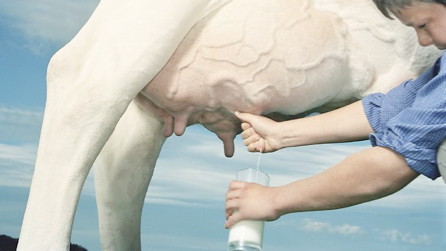
Figure ILF16. Milk straight from the cow. "Those who want to drink milk the way it used to be wonder why it is illegal in a world where alcohol, cigarettes and white bread are available over the counter.." From [36].
Although Australia has made it illegal to sell raw milk for consumption, there are many people who are convinced of the benefits of drinking raw milk. In a December 2011 issue of 'The Australian' newspaper [36], Mark Whittaker reviewed the situation and its chequered history.
He shows how the gradual tightening of regulations, accompanied by official prosecutions, almost led to the bankruptcy of some dairymen. This dismayed consumers who were convinced of the benefits of raw milk. Here are some extracts from Whittaker's article.
"Kate Netschitowsky, from Adelaide, isn't waiting for any more studies. She grew up drinking raw milk from her aunt and uncle's dairy farm. As an adult suffering digestive problems, a constant blocked nose and earaches, her doctor advised her to steer clear of milk. She did not question the advice, nor wonder why milk never used to be a problem."
"Her second child was born with eczema and, at the same time, her cousin gave birth to a son who suffered eczema and asthma so severe he had to be hospitalized. Netschitowsky investigated childhood allergies and came across research showing raw milk had a protective effect. So she fed her daughter raw bath milk and sauerkraut, and in six months the ugly rashes that had covered most of her body had disappeared. Meanwhile, she watched her cousin go through the medical wringer, exhausted by the constant promise that the next drug would work, when it never did, and by the difficulty of avoiding all the usual food suspects - milk, eggs, wheat and nuts."
"Netschitowsky prodded her cousin in the direction of traditional nutrition, but the solution seemed too simple to be true, so the cousin was slow to come around. But she did, and five years down the track the boy has also been cured without drugs, says Netschitowsky. You can't even see his eczema scars any more."
"Numerous studies have demonstrated the link between raw milk consumption and lower rates of asthma, eczema and various allergies. But when a Food Standards Australia New Zealand committee -- consisting of bureaucrats from various government agencies and dairy industry representatives -- looked into the matter in a recent review of whether raw milk should remain illegal, they found that while an association between raw milk and fewer allergies and asthma was clearly demonstrated by well-designed studies, it did not prove that raw milk was superior to pasteurized milk."
"Their reasoning was that raw milk studies were 'consistent with a broader prevailing theory that there is a protective effect from a farming lifestyle'. This was despite the fact that the studies showed city children who'd never been to a farm got the same benefits from raw milk as farm children."
"The latest study of 8300 children, published in the Journal of Allergy and Clinical Immunology in August 2011, showed a 41 per cent reduction in asthma and a 50 per cent reduction in allergies for children who drank raw milk. According to the Weston A. Price Foundation, there are no records of raw milk having ever killed a child. One in 10 Australians has asthma, and 411 died from it in 2009."
When the authorities banned raw milk for human consumption from sale, some suppliers started selling it for consumption by pets. This was also subsequently banned.
The current situation is that people can drink milk from their own animals (goats and sheep, as well as cows), but raw milk can only be sold for purposes other than ingestion. Using the first exemption, some dairymen have sold shares in individual cows to consumers, who collect 'their own' produce and drink it.
Raw milk is still sold legally in Australia. It is labelled 'Bath Milk'. An international website [37] lists sources of raw milk in many countries of the world. A local Australian supplier has the following note on its website.
"Note that unpasteurised milk is sold only for purposes such as bathing milk or cosmetic milk as recommended by the Australian Health Dept. Those that mention that it is for consumption purposes, will not be supplied."
Talking About Shit
By now we should have quite a good picture of what happens when food, solid or liquid, enters your mouth and dives down into the works below. So it's time to talk about where it ends up.
Time to grasp the matter, and talk about reality. Everybody knows what 'shit' means, but some have problems talking about it, because 'shit' is a Bad Word. Still, Wikipedia has an entry for it [17].
Bad Words are an interesting topic, and they too change with time. Let's call terms which only slightly 'off', "Bad1" words. Bad1 words include some twee circumlocutions and technical terms, words such as poo, poop, number twos, faeces, and excreta.
Bad2 words are a little more cringeworthy, words like 'shit' and 'crap', back in BC these words would not be allowed in a printed story. Once, 'shit' would be in the most extreme category, Bad3, but has lost much of its impact in AD. According to Julie Zemiro, the only Bad3 word left in contemporary English is c***, now that f*** has dropped back to Bad2.
Then there are Bad0 words, completely acceptable almost anywhere. These include 'manure', 'droppings' and 'stool' (as in 'stool sample'), but these words only apply in certain contexts. Here we will stick to 'shit', with the hope that it will shortly drop in Badness rating to no more than Bad1.
Of course, all words move up and down the scale. In Chaucer's time, and even in that of Samuel Pepys, in the 1600s, 'shit' was a completely unexceptionable word. Now, in AD, 'nigger' is regarded as very offensive, but back in BC, 'nigger brown' was a normal label on colour charts. While 'joystick', nowadays a Bad0 word, started off as a slang term for 'penis'.
According to Encyclopaedia Britannica online [18], about 100 to 250 grams of shit are excreted by a human adult daily. It's made up of 75% water and 25% solid matter. About 30% of the solid matter consists of bacteria; about 30% consists of indigestible food matter such as cellulose; 10 to 20 percent is cholesterol and other fats; 10 to 20 percent is inorganic substances such as calcium phosphate and iron phosphate; and 2 to 3 percent is protein. Cell debris shed from the mucous membrane of the intestinal tract, and a small amount of other human-origin material, is also found in the shit.
It's notable that 30% is bacteria -- these are non-human cells, organisms which have bred, lived, acted, and been discarded during the digestion process. The proportion of human cells in shit is quite low.
Uses For Shit
Under the name 'manure', animal shit has been used for centuries as a fertilizer for crops. Use of human shit for fertilizer is much less common, though it was routine in China, and probably is still so in some parts of the world.
Eating shit is, surprisingly, not uncommon in the animal world, and in some cases it is vital. The technical term is 'coprophagia', and this has an extensive entry in Wikipedia [22].
Shit actually contains up to 50% of usable food which has not been fully digested. In some countries, horse shit was collected to feed pigs, and even in the United States, cattle are fed chicken litter -- sometimes treated by heating.
Some herbivores, such as such as hamsters and rabbits, may produce 'soft fecal pellets' [22] which still contain a lot of partially-digested grass, and these are consumed immediately, a practice which is important to provide adequate vitamins B and K, produced in their gut by bacteria.
Young elephants, pandas, koalas, and hippos eat the faeces of their mothers or other animals in the herd, to obtain the bacteria required to properly digest vegetation found on the savanna and in the jungle. When they are born, their intestines do not contain these bacteria (they are completely sterile). Without them, they would be unable to obtain any nutritional value from plants.
Termites eat their mother's faeces as a means of obtaining their hindgut protists. Protists are uncomplicated, single-celled organisms, such as algae and simple fungi. Termites and protists have a symbiotic relationship that allows the termites to digest the cellulose in their diet via the protists.
The mothers of newly-born and infant mammals are commonly observed to lick their baby's anal regions, especially if the infant has diarrhoea or a digestive upset. This is said to be so that the mother can develop antibodies to the disorder affecting the baby. These antibodies are then passed on the infant in the mother's milk.
When it comes to human use, consumption of fresh, warm camel faeces has been recommended by Bedouins as a remedy for bacterial dysentery; its efficacy (probably attributable to the antibiotic subtilisin from Bacillus subtilis) was confirmed by German soldiers in Africa during World War II [22].
This use may be amusing, but there are other applications which fall into the life-or-death category. One of these is described by Dr Karl, Australia's foremost science guru.

Figure ILF17. Dr Karl. From [16].
Notwithstanding his taste in loud shirts, Dr Karl was in early 2012 honoured as an 'Australian Living Treasure'. See reference [1] to understand why Australians are quite content to make do with just his first name.
Shit Saves A Life
Here is an extract from [1], which was the script from an ABC Television show.
This is the astonishing story of a 61-year-old woman who was dying from a bowel infection and whose life was saved by a transplant of faeces! Yup, the stuff you find in baby's nappies. The woman had been treated with antibiotics for a pneumonia. Unfortunately, while the antibiotics knocked off her pneumonia, they also knocked off many of the good microbes in her gut. This meant that a truly nasty bacterium, Clostridium difficile, could move in and take over.
After eight months, she was not far from dead. She had lost 27 kilograms, was confined to a wheelchair, and had to wear a nappy all the time because she had nasty diarrhoea every 15 minutes. Nothing her doctors could try had worked. Clostridium is a bad bacterium. Over the last decade, the incidence of Clostridium-associated disease has increased seven-fold, and the bacterium has become more virulent. It's also very speedy at developing resistance to antibiotics. When times are bad, Clostridium can turn into extremely hardy spores, which then re-emerge in easier times. It's now killing more people than ever before. In the UK in 2005, one in every 250 death certificates listed it as a contributing cause of death.
Getting back to our dying woman, her gastroenterologist, Dr Khoruts from the University of Minnesota, had found that her gut had been "colonised by all sorts of misfits. The normal bacteria just didn't exist in her." So he decided on a rather uncommon therapy: faecal transplantation.
Using a colonoscope, he collected 25 grams of faeces from the gut of his patient's husband of 44 years. He mixed them with 300 millilitres of water, threaded a colonoscope into her colon, and squirted them in.
The next day, amazingly, her diarrhoea stopped. Day by day, she began to visibly improve, after a continuous eight-month-long downward trajectory towards death. She had a rapid and complete recovery. Her life was saved by the faecal transplant, or bacteriotherapy, or human probiotic infusion (or poo from her husband).
What, you might ask, inspired Dr Khoruts to try this treatment? Well, we humans have managed livestock for probably 10,000 years. Cows can get indigestion after a change in diet. So farmers have long treated this by sucking fluid out of the stomach of a healthy cow and feeding it to the sick cow. This is working at the top end of the gut, not the bottom end, but the principle is the same.
Getting back to our now-well woman, an analysis done two weeks later showed that her husband's gut microbes had taken over her gut. Dr Janet Jansson, who worked with Dr Khoruts, said that the new microbes: "[did] function and cure her disease in a matter of days. I didn't expect it to work. The project blew me away."
Even in the early 21st century, we still have no real idea of what lives in our gut. There are many, many thousands of different microbe species in the human gut. A Chinese and European team surveyed the genes they found in the gut microbes from 124 people. They found 3.3 million genes. By comparison, the human DNA has only 20,000 genes. There are thousands, if not tens or hundreds of thousands, of species of microbes living in our gut, airways, skin, foreskin, vagina, mouth and so on. They have colonized every available surface of our body. We have no idea of what most of them are.
Asthmatics have different lung microbes than non-asthmatics. Obese people have different gut microbes from skinny people.
The Helicobacter Story
There happens to be one inhabitant of Innerlandia about which quite a lot has become known. It's called Helicobacter pylori, and it's the bacterium associated with stomach ulcers. In an article in Scientific American [20], Martin J Blaser poses the question "Is the decline of Helicobacter pylori, a bacterium living in the human stomach since time immemorial, good or bad for public health?".
Here are some extracts from the article.
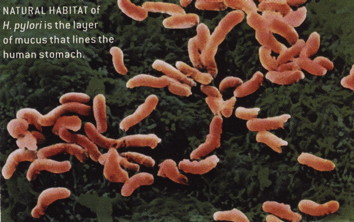
Figure ILF18. Helicobacter. From [20]..
"Helicobacter pylori is one of humanity's oldest and closest companions, and yet it took scientists more than a century to recognize it. As early as 1875, German anatomists found spiral bacteria colonizing the mucus layer of the human stomach, but because the organisms could not be grown in a pure culture, the results were ignored and then forgotten. It was not until 1982 that Australian doctors Barry J Marshall and J Robin Warren isolated the bacteria, allowing investigations of H. pylori's role in the stomach to begin in earnest. Over the next decade researchers discovered that people carrying the organisms had an increased risk of developing peptic ulcers -- breaks in the lining of the stomach or duodenum -- and that H. pylori could also trigger the onset of the most common form of stomach cancer".
"Just as scientists were learning the importance of H. pylori, however, they discovered that the bacteria are losing their foothold in the human digestive tract. Whereas nearly all adults in the developing world still carry the organism, its prevalence is much lower in developed countries such as the US. Epidemiologists believe that H. pylori has been disappearing from developed nations for the past 100 years thanks to improved hygiene, which blocks the transmission of the bacteria, and to the widespread use of antibiotics. As H. pylori has retreated, the rates of peptic ulcers and stomach cancer have dropped. But at the same time, diseases of the esophagus -- including acid reflux disease and a particularly deadly type of esophageal cancer -- have increased dramatically, and a wide body of evidence indicates that the rise of these illnesses is also related to the disappearance of H. pylori.
The theme that the ecosystems that exist within you can have both beneficial and harmful aspects will by now be familiar. An interesting thing that DNA studies reveal about H. pylori is that it is extremely diverse -- there are at least two strains, which differ between themselves in gene counts by 6%, which (according to [20]) is six times the corresponding difference between humans and chimpanzees. Also, both strains can exist within the same individual.
Helicobacter DNA studies have led to an interesting fact about a quite different topic -- that of mankind's migrations across the globe. By checking the proportions of Helicobacter variants in different populations, it is seen that South America was settled overwhelmingly by people from Portugal and Spain, while the distinctive Chinese variant is not significant anywhere outside south and east Asia.
The present Australian population is mostly from north and east Europe, while North America is obviously a blend. Yes, we knew all this anyway, from historical records, but the technique could be usefully applied in cases where the historical record is lacking.
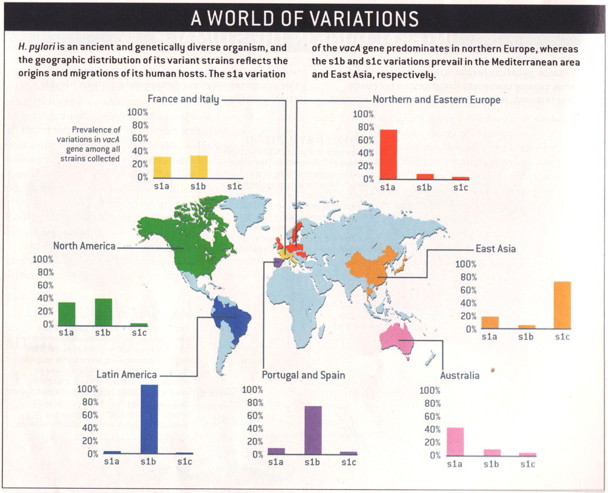
Figure ILF19. Variations in Helicobacter genetics around the world. From [20].
Where Are We Up To, So Far?
OK, so we know that Innerlandia is a densely-populated continent, with many thousands of different species of bacteria and other microbes, and virtually no human cells. We know that these microbes form an ecology, varying in nature from mouth to anus according to the function of the particular area. And we know that disruptions in this set of ecological niches, in particular when they are attacked by antibiotics, can lead to serious illnesses or death of the human host.
We also know that the Innerlandia ecosystem is built up slowly from conception, that its formation continues after birth as many species of microbe are added or fade away, and that in some cases a damaged ecosystem can be restored by adding shit from someone without the same sort of damage to their ecosystem. Moreover, even with a well-functioning ecosystem, it seems that components may need continuous topping-up over the years, just as older people may need vitamin supplements. If Innerlandia could be stoked up to maximum efficiency, could aging be avoided for longer?
We also know that our knowledge of the composition and workings of Innerlandia is very limited. This is an almost completely neglected branch of medicine. While for the other four systems of Planet Corpus we have gained extensive DNA information, this is almost entirely for human cells. DNA analysis of the thousands of microbe species in our guts is very much in its infancy.
And now we come to the crux of the present investigation. As we review the situation here in AD, we can see that there has been an alarming rise in the number of people with disorders and illnesses which were little known or of minor proportions back in BC. This is particularly the case with allergies and other auto-immune diseases, such as diabetes, early-onset dementia, and irritable bowel syndrome, even cancer, characterized by the body being 'out-of-kilter' and attacking itself.
The evidence is stark and surprising. It appears that changes in attitudes and practices, many with the aim of improving public hygiene, have had the opposite effect. By strangling the natural day-to-day input and output balances of our digestive systems, they have introduced or boosted a range of human disorders.
Going By The Book (1)
Early in 2012, I saw a film which was set in modern Iran, a notably religious country. As part of the circumstances of the plot, a woman took on a day-time job helping to look after the aged father of a family while the other family members were out.
The father was suffering from Alzheimers or some other loss of mental acuity, and at one point soiled himself while still fully clothed. The woman considered cleaning up and changing the clothes of the father, but because of the need to be exposed to nakedness of a person outside her family, was in a religious quandary.
She thought she might be committing a sin in the action. In the end, she had to consult a member of the local clergy for advice as to whether she could clean up the father without committing a sin.
For most of us in the West, such a decision would be made without any thought of consulting a set of religious rules. We would consider ourselves as operating well outside such restraints. When it comes to deciding what to do in everyday circumstances, we don't generally think that what we do must be rigidly defined by a book or written code.
It's true that even in the West, many people still have some constraints in this area. Catholics will consult their priests for advice on religious obligations, big-picture decisions on moral issue are still made by the Pope in Rome. In some religious sects, particularly in the US, behaviour rules are set by the head of the sect.
In everyday life, most of us think that we are mature enough to make moral decisions without needing to comply strictly with a written or unwritten code which may have its roots far back in previous centuries. In deciding whether it is proper to download a movie from the Internet (which may possibly still be in copyright), recourse to the Bible may not be of help.
And yet, in modern times the West is operating within an all-permeating code which we feel bound to comply with, and it is one which has grown up and around us insidiously within the lifetimes of older people.
Going By The Book (2)
This code concerns the food we eat. Everywhere today, in newspapers, television, and all forms of the modern media, we are inundated with advice and claims about the things we eat and drink, and the way we do this.
This food is Good For You, that food is Bad For You. You should eat more of this, drink less of that. That meal is 'Junk Food', it should be avoided. Eating this will make you Put On Weight.
Once again, Australia probably leads the field in Regulation. The authorities definitely know what is good for you, and are determined that you Obey. Here is an example in the area of foods to be available in Australian schools.
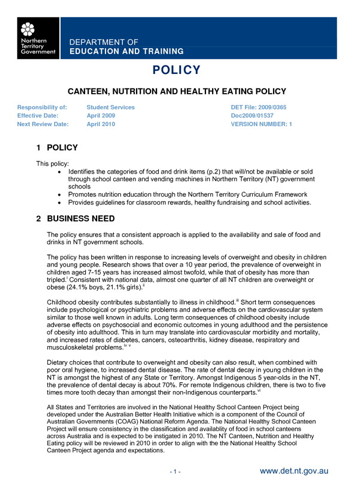
Figure ILF20 Northern Territory School Canteen Policy. From [39].
Here are some relevant extracts from the start of this document [39].
"This policy identifies the categories of food and drink items that will / will not be available or sold through school canteens and vending machines in Northern Territory government schools."
"The policy has been written in response to increasing levels of overweight and obesity in children and young people. Research shows that over a 10 year period, the prevalence of overweight in children aged 7-15 years has increased almost twofold, while that of obesity has more than tripled."
"Childhood obesity contributes substantially to illness in childhood. Short term consequences include psychological or psychiatric problems and adverse effects on the cardiovascular system. Long term consequences include adverse effects on psychosocial and economic outcomes in young adulthood and the persistence of obesity into adulthood. This in turn may translate into cardiovascular morbidity and mortality, and increased rates of diabetes, cancers, osteoarthritis, kidney disease, respiratory and musculoskeletal problems."
"Dietary choices that contribute to overweight and obesity can also result to increased dental disease. The rate of dental decay in young children in the NT is amongst the highest of any State or Territory."
And later on, some of the grisly details:
"4. Foods/Drinks that will not be available at all. Confectionery including chocolate, carob, cough lollies; Soft drinks (including diet), flavoured mineral water, cordial, sports drinks and fruit juice drink; Energy-high caffeine drinks (e.g. drinks containing guarana); Deep fried foods of any description e.g. spring rolls, dim sums etc; Deli meat e.g. fritz, salami, devon; Cup style noodles and full fat 2-minute noodles; High sugar spreads e.g. jam, honey, hazelnut spread; Foods such as pastry items, hot dogs, sausages and pre-packaged, cooked hot meals (unless School Approved); Cakes, biscuits, bars, muffins and snack foods (sweet/savoury); Ice creams and icy poles."
The Canteen Nazis Rule, OK?
Of course, no-one should doubt this -- the Canteen Nazis, they Mean Well. In a way, they are concerned about the same health problems as I am. Is there the least shred of evidence that their course of action will have any effect? Would the same approach cut the soaring diabetes rate in Egypt?
In actual fact, the evidence is that the highly prescriptive approach to what children eat is definitely inferior. Studies on two comparable groups of children fed school meals have shown that the group allowed to eat just what they liked, from a varied selection, grew better and were more healthy than the group fed standard meals with no choice.
Of course, as might be expected, children in the eat-what-you-like group tended to binge out on chips, icecream, chocolate, etc, in the early stages. But surprisingly quickly, their tastes settled out and they were soon eating more 'balanced' meals by choice -- though the balance might be different to that favoured by the pundits.
The whole of the West, in AD, is fixated on people's weights. Publications are full of detailed diets, often with contradictory recommendations. Fat people get fat because they eat too much fat. Is your BMI (Body Mass Index) right?
Gradually, over the years, an enormous and pervading societal structure has been built up to tell you what to eat and drink, how to exercise and live your life. And most of it is rubbish, built on shaky foundations. For example, the BMI formula is flawed at the most fundamental level -- it assumes that mass increases as the square of the linear dimension, whereas in fact mass varies as the cube of length.
If people are concerned about their weights, fair enough. We've already had two hints earlier in this article about a possibly better approach than dieting. "Obese people have different gut microbes from skinny people". "Germ-free rodents have to consume nearly a third more calories than normal rodents to maintain their body weight, and when the same animals were later given a dose of bacteria, their body fat levels spiked, even if they didn't eat any more than they had before."
The possibility? That your body weight may be adjustable simply by changing the microbe mix in your digestive system.
Loss Of Appetite
Back in BC, the picture was quite different. All the hullabaloo about what you should be eating just didn't exist. No cooking reality shows on TV. Women's magazines did, it is true, have recipes on how to cook good cherry cakes, but that was about it.
People back in BC used a different method to work out what they should eat. It was called their Appetite. This amazingly effective device not only alerted the owner to what their body needed, it automatically adjusted to different conditions and environments. And it was finely tuned to the particular individual.
A Little Of What You Fancy Does You Good
Of course, as with any sort of appetite, it's possible to go overboard. And people do get stuck in their ways, so their appetite may no longer automatically adapt to changing circumstances.
But your appetite has the potential to help you choose. Your body needs a certain amount of a trace element, selenium, to function correctly. In some parts of the world, such as southwestern Western Australia, the soils are deficient in selenium, and cattle raisers have to provide 'salt licks' containing selenium to raise healthy cattle.
Because much of their food is sourced from outside the region, local WA people do not usually have selenium deficiency. Brazil nuts are a good source of selenium, so when people have a craving for Brazil nuts, their body may be telling them something. If they add a selenium supplement to their intake, the craving may disappear.
There is also the question of source amounts. If you have a craving for a particular food, your body may be seeking a vitamin or substance present only in tiny amounts. To get the right amount of vitamin, you may have to consume a lot more of the food which contains it than your body needs for energy purposes.
When you look at the school-canteen food situation critically, it is obvious that the poor Northern Territory kids have been absolutely cut off from their natural guides -- their appetites -- in what they eat. Go through the list again, and you'll see that anything a normal kid might actually like to eat is banned. The authorities operate to prevent the kids using their internal guides to work out what they need.
Constrain your diet to exactly what the Authorities prescribe (inevitably an average over the whole population), and you lose all the infinite precision your appetite and cravings might provide. Don't go by the book!
Stoking your microbe boilers
We've already seen how important all the microbes you lose when milk is pasteurized may be. There are other microbe sources which used to be present in common foods, but have quietly disappeared since BC.
Take cheeses. Cheeses are produced from milk, an agent called rennet is then added to precipitate solids, and cheese biological cultures are added -- the particular culture is what defines the type of cheese produced (cheesemakers can develop their own cultures, to get distinctive types of cheese). Here's some of what Wikipedia says on Cheesemaking [42].
"Cheesemaking may originate from nomadic herdsmen who stored milk in vessels made from the sheeps' and goats' stomachs. Because their stomach linings contains a mix of lactic acid, wild bacteria as milk contaminants and rennet, the milk would ferment and coagulate. A product reminiscent of yogurt would have been produced, which, through gentle agitation and the separation of curds from whey would have resulted in the production of cheese; the cheese being essentially a concentration of the major milk protein, casein, and milk fat. The whey proteins, other minor milk proteins, and the lactose are all removed in the cheese whey."
Cheese still contains many useful contributors to Innerlandia's microbe mix. However, the contribution from rennet has changed, it is no longer the original BC material.
Rennet
If you look in an old dictionary (such as Lloyd's Encyclopaedic Dictionary, 1895) you'll find a definition for rennet along the lines of: "An aqueous infusion of the dried stomach of a calf. It is a valuable agent in the coagulation of the casein of milk preparatory to the manufacture of cheese".
Cheesemakers in AD use 'non-animal rennet', simple cultures now removed from connection with calf stomachs. Junket, a material used to make solid puddings from milk, also once used rennet, but now is a simple culture.
Probiotics
Products such as yoghurt are good sources of useful bacteria and are acknowledged to be helpful in digestion. But again, they usually contain only two or three microbe types, maintained in simple culture, compared to the hundreds of types which may be present in raw milk.
Sausages, Tripe, and Haggis
Back in BC, all sausages were supplied in natural skins, technically called 'casings' [26]. Some readers may be surprised to know that these skins were made from the cleaned intestines of animals. It would not be impossible for some of the digestive system microbes to survive through to the completed sausage.
A material called collagen makes up 75% of intestinal walls and other types of skin. Collagen can be extracted from the hides of cattle and other animals, and re-formulated for use in 'artificial' sausage skins. The product is well suited for use in high-speed sausage-making machines, which produce the bulk of sausages sold in supermarkets.
According to Perth specialist sausage manufacturer Paul Marinovich, natural sausage skins are still preferred for the best-quality products, though they cost more and are harder to use than collagen ones. Interested in a tip to tell the two apart in the store? The natural skins tend to give a curve to the sausages, the machine-made ones are straight.
Tripe is a type of edible offal from the stomachs of various farm animals. Back in BC, it was a common and cheap source of protein, but is little seen these days.
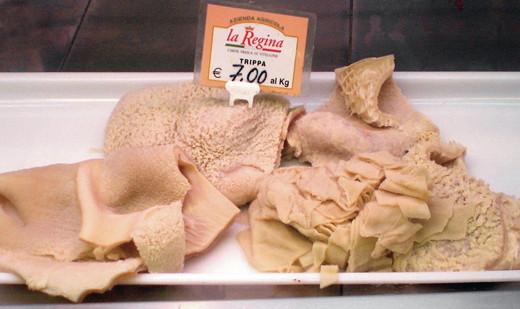
Figure ILF21. Tripe on sale in an Italian Market. From [43].
Haggis is a kind of savoury pudding containing sheep's pluck (heart, liver and lungs), minced with onion, oatmeal, suet, spices, and salt, mixed with stock, and traditionally encased in the animal's stomach and simmered for approximately three hours. Most modern commercial haggis is prepared in a sausage casing rather than an actual stomach.
All these goods incorporate parts from animal digestive systems. Microbes from these will normally be destroyed by cooking.
An Apple A Day Keeps The Doctor Away
Many of the fresh foods from the vegetable kingdom that we eat come with their own natural micro-organisms, and more may be added en route to our stomachs.
Take apples. We eat them fresh, including their skins. Even with increasing mechanization, many apples are still picked by hand -- possibly by the hand of a foreign backpacker who had been 'caught short' in the orchard and did his business there. Almost certainly the apple was handled by the member of your family who went to the market to buy it.
Other fruits normally eaten complete with skins include plums, nectarines, strawberries, and grapes. Grapes come with their own load of yeasts -- they form the 'bloom' on the skin. Washed carrots, grated and eaten raw, and chopped cabbage and lettuce salads will all have some small carry-over from their previous environment.
While fruits and vegetables are accepted as 'good for your health', especially if raw, could some their benefit be in this incidental load?
Antibiotics
Antibiotics have been one of the great modern health developments, transforming and extending lives throughout the world. But they do have a massive downside.
Of all the changes in medicine over the last 80 years, very possibly no factor would better correlate with the rise in auto-immune disorders, than the rise in use of antibiotics.

Figure ILF22. Antibiotic pills. From [44].
We've seen several instances above, where ingestion of antibiotics has had a bad, sometimes devastating, effect on people's digestive systems. Antibiotics are the Agent Orange to Innerlandia's jungles.
It's almost impossible to contemplate a future without antibiotics, but sensible changes to their use can be made. It's commonly accepted that over-use of particular types of antibiotics has 'built up resistance' to them [44]. How could this problem be minimized?
Here's a case where a little Base Logic may be effective. Why are most antibiotics swallowed? The disorders that they are intended to tackle are not usually in the gut, but elsewhere in the body. It would seem logical to bypass Innerlandia completely, and deliver antibiotics more directly to the target sites -- by injection, by inhalation, by absorption through skin patches, and so on.
It's also accepted that antibiotics are sometimes used even though the disorder involved is not known to respond to them. This is a common occurrence with virus-based diseases.
Finally, a little failsafe logic. Sometimes the Agent Orange approach will be the only one available, even though the danger of decimating the gut microbe mix is recognized. Store a little of the patient's shit as a backup, maybe frozen, and their inner jungle may be rapidly restored if necessary from this.
No Man Is An Island
We exist in complex and changing environments, in which there is continual interchange between us and these environments -- interchange in energy, substances, and organisms.
It's probably a mistake to regard all interaction with organisms such as microbes as bad, there may be benefits as well as disadvantages. With a sufficiently detailed viewpoint, the complexity of such interchanges can be seen as enormous.
It can be valuable to re-examine the system, looking for some of the ways things in our living situation have changed, often in the most subtle and unnoticed manner. Many of these changes have made it harder, or even impossible, for previously-common microbe transfer to occur.
As an example, in 'Western' countries, health standards in public, business, workplace, and home toilets (US: rest rooms; UK: lavatories) are generally quite high. Toilet paper is provided, plus a washbasin for hand-washing after use. In less-developed countries, this may not be true, though in Muslim and French-colonial cultures, water jets to clean the bottom may be provided.
Your toilet doorknob may be an excellent place to keep up a small but steady transfer of organisms between members of the family -- and visitors.
The insects which plague and bite us, such as mosquitos and fleas, take our blood. They also inject stuff into our bloodstreams, including bad stuff like malaria. But they play a role in exchanging blood substances between people, or between people and animals.
With every breath we take, we accept a host of outside organisms into the lungs, and put out another set as we breath out. Some of these things, like the pollen grains which trigger hay fever, can be a real annoyance. The advent of vacuum cleaners has greatly reduced the impact of dust mites from carpets and floors. But some minor items may possibly 'condition' Breathlandia to accept later, larger, influxes without allergic reactions.
This article has been mainly about the digestive system, about Innerlandia. But Innerlandia exists as part of a greater system, the body, which itself exists within a local environment.
You Could Probably See Where All This Is Leading ...
OK, plain speaking now. It seems likely that a number of human ailments might be significantly reduced in number and incidence by judicious addition of shit to the diet.
Of course, I'm certainly not recommending that you do this. If I did, I'd be swamped by people telling me what a bad idea it would be.
And it shouldn't be attempted without thought. While it might be easy enough to round up shit donations from relatives and friends, pop them into the blender with some water, pass through a tea strainer, and drink up, it would be better to have a plan.
Remember that the lumpy solids in shit are not the good bits. Size is important. Most human cells are around 10 microns in size (a micron is a millionth of a metre). Bacteria may be a hundred times smaller [27], perhaps only a tenth of a micron across.
A useful ruler in deciding whether cells are animal, plant, or bacterial, is one 5 microns long. Bacterial cells are usually less than 5 microns across, animal and plant cells are above this size. Perhaps not by coincidence, the microvilli which fence off Innerlandia from the rest of the body are also about 5 microns in size.
What this means in practice, is that if we use a filter with holes around 5 microns across to strain the blender output, the liquid coming through the filter will contain most of the bacteria. Other materials, such as undigested food, will be strained off.
Handily, filter papers which would fit in your coffee filter funnel can take out everything bigger than 5 microns [29]. And if you want to work at a bigger scale, filters with holes as small as one micron are a standard item in the water industry, and can be bought off the shelf [28].
The biggest drawback about ingesting untreated shit products, is that they may contain gut parasites or eggs from these. Most of these are much bigger than 10 microns, and would be filtered off if present. A single-celled protozoa called Giardia, occurring in many animal guts, is regarded as a parasite. Its cysts are about 10 microns across.
Of course this is all a simplification. An excellent analysis of gut flora, parasites, and gut leakage is at [32]. A good general rule would be to use shit only from apparently healthy donors -- if you ever considered doing something like this.
Dr Karl's article above [1] has its representation in the medical literature. In [22] it says: "Fecal bacteriotherapy is when feces from a close relative or spouse are given to patients suffering from intractable diarrhea caused by Clostridium difficile. The purpose is to repopulate the intestines with the normal gut flora (intestinal bacteria) to decimate the clostridium. The healthy stool is administered by nasogastric tube, enema, or in a capsule."
Of course a 'nasogastric tube' is a tube shoved down through your nostril to the stomach. Not too different to eating shit, really. Note that the technique uses the Matrix approach -- don't try to kill an unwanted 'bad' organism, instead swamp it with 'good' organisms.
Some Propositions
There's a lot to think about in what's been said above. Some of it may be disturbing, even offensive. Quite a lot of it may be arguable. Let's summarize some of the main points in a series of Propositions -- not statements of fact, but statements put up for examination, maybe refutation.
Proposition 1. Efficient and stable operation of the human digestive system has a significant effect on the health of the human involved.
Proposition 2. Stability of the digestive system depends on a balance between all the organisms and substances active within it.
Proposition 3. This balance is achieved and maintained through initial seeding and adaptation, and regular input of substances and organisms.
Proposition 4. Input of substances, and especially of organisms, has been restrained in recent decades by changing public health regulations and changed social attitudes.
Proposition 5. General public health levels might be improved by introducing or re-introducing practices which promote ingestion of suitable microorganisms.
Proposition 6. Antibiotic use may be a major disruptor to the balance of the digestive system.
Entrenched common views on human health and standard approaches to medicine have not made much of a success so far in dealing with the rise of auto-immune disorders. The propositions above may be of help in tackling new approaches to the problem.
But it's only a start. There is so much more to find out, so much more research and analysis to be done. Good luck, World!
* * * * * * * * * * * * * * * * * * * * *

References and Links
1. Karl Kruszelnicki. Dr Karl's Great Moments In Science: Human poo transplant treats gut-wrenching disease. http://www.abc.net.au/science/articles/2011/04/19/3194662.htm .
2. Composition of the human body. From:
http://en.wikipedia.org/wiki/Composition_of_the_human_body .
3. Humans Carry More Bacterial Cells than Human Ones . From:
http://www.scientificamerican.com/article.cfm?id=strange-but-true-humans-carry-more-bacterial-cells-than-human-ones .
4. Capstick Comes Home. http://www.youtube.com/watch?v=I2AcJSkUw6M .
5. Cast Iron Village Pump. From:
http://image.made-in-china.com/4f0j00ivdTYzcfYgbB/Cast-Iron-Village-Pump.jpg .
6. Health & Safety by the Oval.
http://www.egpropertylink.com/blogs/london-residential-research/cricketers.JPG .
7. Dick Tracy.
http://en.wikipedia.org/wiki/Dick_Tracy .
8. David Noel. The Substance of Society -- Infocap. http://www.aoi.com.au/matrix/Mat02.html .
9. Diagram of Human Digestive System.
http://www.vitallywell.net/images/digestive-system-diagram.jpg .
10. Small Intestine.
http://www.highlands.edu/academics/divisions/scipe/biology/faculty/harnden/2122/images/villilact.jpg .
11. Beatrice stove. http://www.spiritburner.com/fusion/gallery/2184/1302103394-Beatrice_2.JPG .
12. Antarctica. http://www.diegocuoghi.it/Piri_Reis/Antarctica-Maud.gif .
13. Michael Swift. Mapping the World. Chartwell Books, 2006, p.67.
14. History of Antarctica.
http://en.wikipedia.org/wiki/History_of_Antarctica .
15. Shit. http://en.wikipedia.org/wiki/Shit .
16. Karl Kruszelnicki. http://www.abc.net.au/reslib/200803/r234200_939722.jpg .
17. Melinda Wenner. Humans Carry More Bacterial Cells than Human Ones . http://www.scientificamerican.com/article.cfm?id=strange-but-true-humans-carry-more-bacterial-cells-than-human-ones .
18. Feces. http://en.wikipedia.org/wiki/Faeces .
19. Feces. http://www.britannica.com/EBchecked/topic/203293/feces .
20. Martin J Blaser. An Endangered Species in the Stomach. Scientific American 2005 Feb, pp.24-31. Preview at: http://www.scientificamerican.com/article.cfm?id=an-endangered-species-in .
21. Ann Nolan. Sugar Consumption and Diabetes. http://zombal.com/zomb/scientific-question/wanted-table-of-consumption-of-types-of-sugar-in-many-countries-of-the-world .
22. Coprophagia. http://en.wikipedia.org/wiki/Coprophagia .
23. David Noel. What Is Matrix Thinking? http://www.aoi.com.au/matrix/Mat01.html .
24. Global prevalence estimates of Diabetes for the year 1995, 2000 and 2030. http://assets.zombal.com/5b69bd58/wanted-tables-of-world-incidence-of-diabetes.pdf .
25. David Noel. Matrix Thinking. BFC Press, Subiaco, 1997. Online version: http://www.aoi.com.au/matrix/MT.htm .
26. Casing (sausage). http://en.wikipedia.org/wiki/Casing_(sausage) .
27. Marshall Brain. How Cells Work. http://science.howstuffworks.com/environmental/life/cellular-microscopic/cell1.htm .
28. 1 Micron Water Filter For Water Industry. http://www.alibaba.com/showroom/1-micron-water-filter.html .
29. Qualitative Filter Papers -- Standard Grades. http://www.whatman.com/QualitativeFilterPapersStandardGrades.aspx .
30. Terrigal Primary School - School uniforms - School hat.
http://www.terrigal.ps.education.nsw.gov.au/schooluniforms.htm .
31. Andamanese people. http://en.wikipedia.org/wiki/Andamanese_people .
32. Leo Galland. Intestinal Parasites, Bacterial Dysbiosis, and Leaky Gut. http://mdheal.org/parasites.htm .
33. Richard Cohen. Chasing The Sun. Simon & Schuster, 2010.
34. Vitamin D. http://en.wikipedia.org/wiki/Vitamin_D .
35. Flatulence. http://en.wikipedia.org/wiki/Flatulence .
36. Mark Whittaker. The White Stuff. http://www.theaustralian.com.au/news/features/the-white-stuff/story-e6frg8h6-1226214968384 .
37. Where Can I Find Real Milk? http://www.realmilk.com/where-other.html .
38. Breastfeeding Protects Against Asthma Up To Six Years Of Age. http://www.pharmacy-today.co.nz/media-releases/2012/february-2012/10/breastfeeding-protects-against-asthma-up-to-six-years-of-age.aspx .
39. School Canteen Guidelines. http://www.docstoc.com/docs/71931892/School-Canteen-Guidelines---POLICY .
40. Indian Myna Chicks. http://www.yimag.org.au/indian-myna-identification.html .
41. Dandelion Clocks. http://littlemisshawha.blogspot.com.au/2010_05_01_archive.html .
42. Cheesemaking. http://en.wikipedia.org/wiki/Cheesemaking .
43. Tripe. http://en.wikipedia.org/wiki/Tripe .
44. GPs 'Must Stop' Overuse Of Antibiotics. http://news.sky.com/home/world-news/article/16112867 .
Stablemate articles:
The Substance of Society -- Infocap. http://www.aoi.com.au/matrix/Mat02.html.
What Is Matrix Thinking? http://www.aoi.com.au/matrix/Mat01.html
Go to the BCW Home Page
Draft Versions, 1.0, 2012 Jan 25; 1.1-1.6, Feb 8-Mar 21;
Version 1.9, First draft up on Web, 2012 Mar 22;
Final general release V. 2.0, 2012 Mar 27
V. 2.2, minor changes, Apr 5, 19, May 27
V. 2.21, technical adjustments, 2014 Jun 21
























